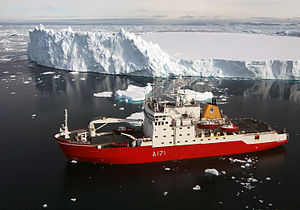 HMS Endurance off the Antarctic Peninsula, in 2007.
| |
| History | |
|---|---|
| Name |
|
| Operator | Royal Navy |
| Builder | Ulstein Hatlo |
| Completed | 1990 |
| Commissioned | 21 November 1991 |
| Out of service | 2008 |
| Homeport | Portsmouth |
| Identification |
|
| Motto |
|
| Nickname(s) | The Red Plum (from the colour of her hull). |
| Fate | Scrapped |
| General characteristics | |
| Type | Icebreaker |
| Displacement | 6,100 t (6,004 long tons) |
| Length | 91 m (298 ft 7 in) |
| Beam | 17.9 m (58 ft 9 in) |
| Draught | 8.5 m (27 ft 11 in) |
| Ice class | 1A1[citation needed] |
| Propulsion | 2 × Bergen BRG 8 Diesels, 8,160 hp (6,085 kW) |
| Speed | 14 knots (26 km/h; 16 mph) |
| Range | 24,600 nmi (45,600 km) at 12 kn (22 km/h; 14 mph) |
| Boats & landing craft carried | James Caird, Nimrod, Eddie Shackleton and Dudley Docker |
| Troops | Royal Marines |
| Complement | 126 |
| Crew | Royal Navy, civilian researchers |
| Sensors and processing systems | Type R84 and M34 surface search radar, Type 1006 navigation radar |
| Electronic warfare & decoys | Classified |
| Armament |
|
| Aircraft carried | 2 × Ice-modified Lynx HAS 3 helicopters |
| Aviation facilities | Full aircraft facilities and double hangar |
HMS Endurance was an icebreaker that served as the Royal Navy ice patrol ship between 1991 and 2008. Built in Norway as MV Polar Circle, she was chartered by the Royal Navy in 1991 as HMS Polar Circle, before being purchased outright and renamed HMS Endurance in 1992 as a replacement for the previous HMS Endurance whose hull had been weakened by striking an iceberg.
Endurance was a class 1 icebreaker. Her two Bergen BRG8 diesel engines produced over 8000 shaft horsepower enabling her to travel through ice up to 1 metre (3 ft 3 in) thick at 3 knots (5.6 km/h).[1] Her propulsion system used a computer-controlled variable-pitch propeller and stern and bow thrusters. She carried two ice-modified Lynx helicopters which were instrumental in the making of the BBC Documentary Series Planet Earth in 2006.
The ship was laid up in Portsmouth from 2009 to 2016, following serious damage caused by flooding following an error during routine maintenance on a sea suction strainer. In October 2013 it was reported that she would be scrapped;[2] in July 2015 the vessel was offered for sale for further use or recycling and left Portsmouth under tow to the Leyal ship recycling facility in Turkey on 1 June 2016.[3]
- ^ "HMS Endurance 3 (Ex- Polar Circle) Ice Patrol Ship". GlobalSecurity.org. Retrieved 6 June 2011.
- ^ Cite error: The named reference
BBC_scrappedwas invoked but never defined (see the help page). - ^ "Advance Notice for the Sale of Former HMS Endurance" (PDF). Ministry of Defence. 14 July 2015. Retrieved 14 July 2015.